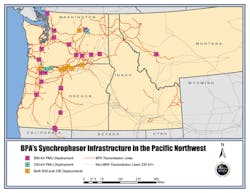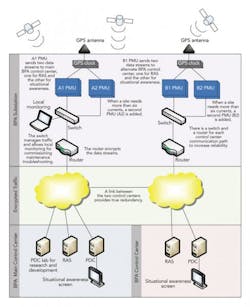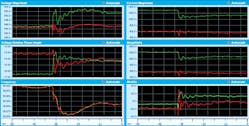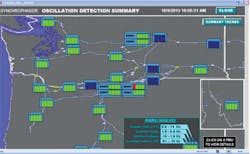It was, quite literally, a dark day for the energy industry: On Aug. 14, 2003, a power failure in Ohio triggered a chain reaction across 600 miles (966 km) of the United States. The cascading outage not only left 50 million people in eight Midwest and Northeast states in the dark, it also raised serious questions about the state of the nation’s electric grid.
A decade after the largest blackout in the country’s history, smart grid devices known as phasor measurement units (PMUs), or synchrophasors, are opening the eyes of grid operators everywhere. But, at the Bonneville Power Administration (BPA), engineers are taking the technology to new levels. The agency now has the largest, most sophisticated synchrophasor network in North America, and it is the only network in the West designed to take split-second automated control actions when it detects a problem on the grid. This is the future of power grid operations.
Old and New
For decades, utilities relied on supervisory control and data acquisition (SCADA) systems, which produced grid readings every 2 seconds to 4 seconds, and none of these measurements were time synchronized. Now, PMUs can crank out precise power system parameters a hundred times faster, providing an unprecedented view of power system dynamics. BPA’s PMUs are set to report power system data 60 times per second. This massive boost in resolution is akin to making the technology leap from black-and-white to 3-D color television.
PMUs take current, frequency and voltage readings and time-stamp them using GPS. These measurements are then transmitted over a high-speed broadband network to BPA’s control centers. The result is a turbocharged feed of power system data that provides grid operators real-time intelligence so they can react more quickly to system disturbances and take actions to avoid a blackout or prevent a disturbance from cascading.
Western Interconnection Synchrophasor Program
In August 2003, grid operators did not realize what was happening until it was too late. Today, BPA and others in the West are making wide-area situational awareness a reality. As part of the Western Interconnection Synchrophasor Program (WISP) led by the Western Electricity Coordinating Council, BPA, along with 18 utility and technology partners, is building a network of more than 600 PMUs across the western grid. BPA and its WISP partners have achieved a true industry game changer that has facilitated a whole new level of cooperation among the energy entities in the West, and it results in a more reliable and secure Western Interconnection.
WISP was partially funded with US$53.9 million by the American Recovery and Reinvestment Act of 2009 stimulus funds and is part of the Department of Energy’s Smart Grid Investment Grant program. The program blends the latest synchrophasor technology with a more robust telecommunications system to give the many transmission operators from Canada to Mexico a much clearer view of the entire transmission system in the West. With all the measurements synchronized to GPS, BPA can see more precisely how all the interconnected power systems in the West are responding to changes or disturbances.
In addition to early detection of equipment failures, the system monitoring and operations from the $108 million network improves the integration of renewable energy, such as wind, and unlocks stability-limited capacity, which translates to more efficient power flow on the grid.
BPA’s work with synchrophasors goes well beyond WISP. In fact, the agency was one of the early adopters of the technology. In the 1980s, it worked with inventors of the technology to optimize the devices for application on the electrical grid. Then, in the 1990s, BPA was the first in the industry to assemble PMUs into a network, stream real-time data from substations to its control center and time-align the multiple data streams. In 2013, BPA completed its build out of an unparalleled synchrophasor network as part of a three-year, $30 million synchrophasor project to enhance the Northwest’s generation and transmission systems.
BPA is now receiving data from 126 PMUs at 50 key substations and large wind-generation sites throughout the Northwest. The agency is initially focusing on using the PMU data to understand system performance issues, set safer operating limits and inform its grid-reinforcement decisions. So far, the agency has integrated the PMU data into displays for its dispatchers.
It also is the only fully redundant synchrophasor network in the West. Because there is a minimum of two PMUs at each site, two streams of data are always available — one at each of the agency’s control centers. On top of that, the two control centers share a link of encrypted data, which provides true operational redundancy. So if a stream is interrupted or erroneous, the system automatically uses the feed from the other control center.
Behind the Scenes
Launching the first synchrophasor project of this scale and complexity presented many new technical challenges. It took the proficiency and creativity of a multidisciplined team to overcome them, including experts in telecommunications, cybersecurity, power grid operations, control center hardware and software, network planning and top-level project management. Through consummate planning and coordination, the team completed design and installations in two-and-a-half years, many of which were critical 500-kV sites on the power grid.
One of the key design drivers was designing the system for response-based controls. BPA is the only WISP partner planning to use wide-area synchrophasor measurements for wide-area controls, which will determine voltage-stability risks and initiate corrective actions within less than 1 second. And, because BPA will use the synchrophasor data for real-time control applications and operational decision making, the data must meet much more stringent cybersecurity requirements. The project team developed innovative, comprehensive strategies to respond to these challenges.
Two areas BPA has zeroed in on since the deployment are data availability and validity — drivers that help the agency define its testing criteria for the units. Additionally, the team developed a comprehensive list of features and specifications of other technology deployments touched and aided into production by BPA’s PMU network, such as a next-generation Ethernet telecommunications network. The integration of synchrophasor data into BPA’s operations center will be used to manage this and other advanced networks.
Data, Data and More Data
A PMU-enhanced system generates an avalanche of data. BPA is now collecting 137,000 measurements every second across the Northwest grid, which adds up to a terabyte of data every month. Vickie VanZandt, BPA’s former senior vice president of transmission and now program manager of WISP, once observed the system made the utility “data rich, information poor.” This premise is behind another one of BPA’s PMU-related efforts. Led by its technology innovation office, BPA is at the forefront of research aimed at translating the data into actionable intelligence.
At the agency’s synchrophasor lab in Vancouver, Washington, U.S., BPA engineers developed an application engine to analyze the real-time data and alert agency dispatchers of risks on the power system. Because there was not a suitable off-the-shelf product, BPA’s team developed four in-house applications that could run a suite of customizable, real-time analytics and visualization displays. The application can process about 18,000 PMU measurements per second and is now being used by other utilities to archive and manage their PMU data.
BPA has been a leader in using disturbance recordings for power plant model validation and performance monitoring. The agency started installing PMUs at power plant interconnections following Western Interconnection outages in 1996. Today, BPA planners have visibility of 115 generators with a total capacity of about 20 GW. BPA developed an application capable of assessing the dynamic performance of its generating fleet within minutes of a power grid disturbance.
The benefits of such monitoring include reduced cost-of-model validation, which is now required by the North American Electric Reliability Corp. standards, as well as early detection of generator control failures. With 5,000 MW of wind-generating capacity connected to BPA’s grid, the focus is on improving dynamic monitoring of wind-generation facilities. The agency is collaborating with the Utility Variable Generation Integration Group, Electric Power Research Institute, and national labs to develop and validate dynamic models for wind power plants.
Another benefit of the synchrophasor technology is the detection of power oscillations. Low-frequency power variations among parts of the interconnection can make the grid unstable, limit the transfer of power on the system and even cause system separation if they go unchecked. On Aug. 10, 1996, growing power oscillations led to system separation and left more than 7 million customers without power. BPA’s new oscillation-detection application provides dispatchers with an early warning of oscillation risk on the power system, and the agency expects it will help operators to avoid at least one large-scale outage in the next 40 years.
The Smart Grid Has Arrived
If the 2003 outage exposed a need to improve real-time visibility across the grid, there was another stark reminder eight years later. A lack of information sharing among transmission operators was one of the causes cited for the 2011 Southwest blackout, where, in just 11 minutes, an outage in Arizona triggered a series of events on five separate power systems. It blacked out nearly 7 million people across much of Southern California and western Arizona, becoming the largest power outage in California history.
In the wake of the 2003 and 2011 blackouts, PMUs are evidence that a smarter, more connected grid has arrived. With its PMU coverage, BPA is better equipped to respond to disturbances and equipment failures than ever before, ultimately increasing grid reliability, improving use of transmission assets and enabling integration of renewable generation.
Dmitry Kosterev ([email protected]) received his doctorate in electrical engineering from Oregon State University in 1996. As a principal electrical engineer in Bonneville Power Administration’s transmission planning group, his responsibilities include studying and planning transmission infrastructure, power system controls, power system modeling, power system performance analysis and reliable integration of renewable resources. From 2007 to 20011, he served as a chair of the Western Electricity Coordinating Council’s Modeling and Validation Work Group. He now chairs WECC’s Joint Synchronized Information Subcommittee and the Planning Implementation Task Team for the North American Synchrophasor Initiative.
Lawrence Carter ([email protected]) is a senior project manager in Bonneville Power Administration’s transmission group, where he was one of the managers of the agency’s synchrophasor project. Carter has a BSEE degree from Washington State University, a MBA degree from City University and a project management professional credential from the Project Management Institute. He is a registered professional engineer in the state of Oregon.
Scott Lissit ([email protected]) is a senior project manager in Bonneville Power Administration’s transmission group, under contract through David Evans & Associates, where he has served as one of the managers of the agency’s synchrophasor project. Lissit has a MSME degree from the University of Michigan and a project management professional credential from the Project Management Institute. He has been active in the North American Synchrophasor Initiative.
Companies mentioned:
Bonneville Power Administration | www.bpa.gov
Department of Energy | www.energy.gov
Electric Power Research Institute | www.epri.com
North American Electric Reliability Corporation | www.nerc.com
Utility Variable Generation Integration Group | www.uwig.org
Western Electricity Coordinating Council | www.wecc.biz







